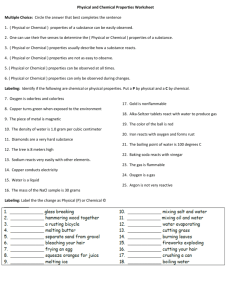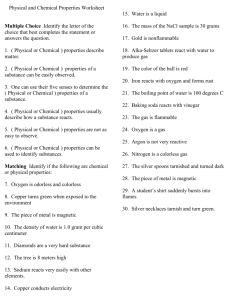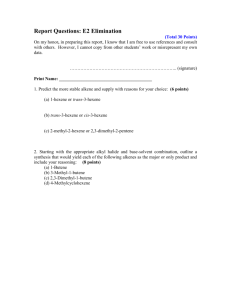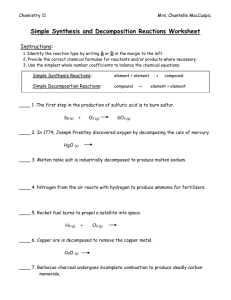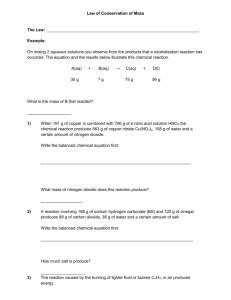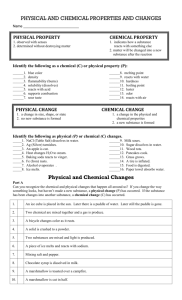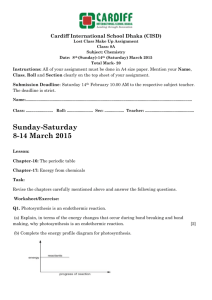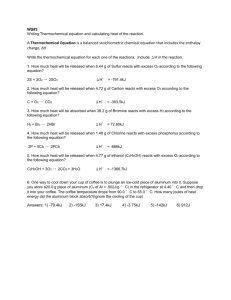Identify the chemical names and formulas in this list
advertisement
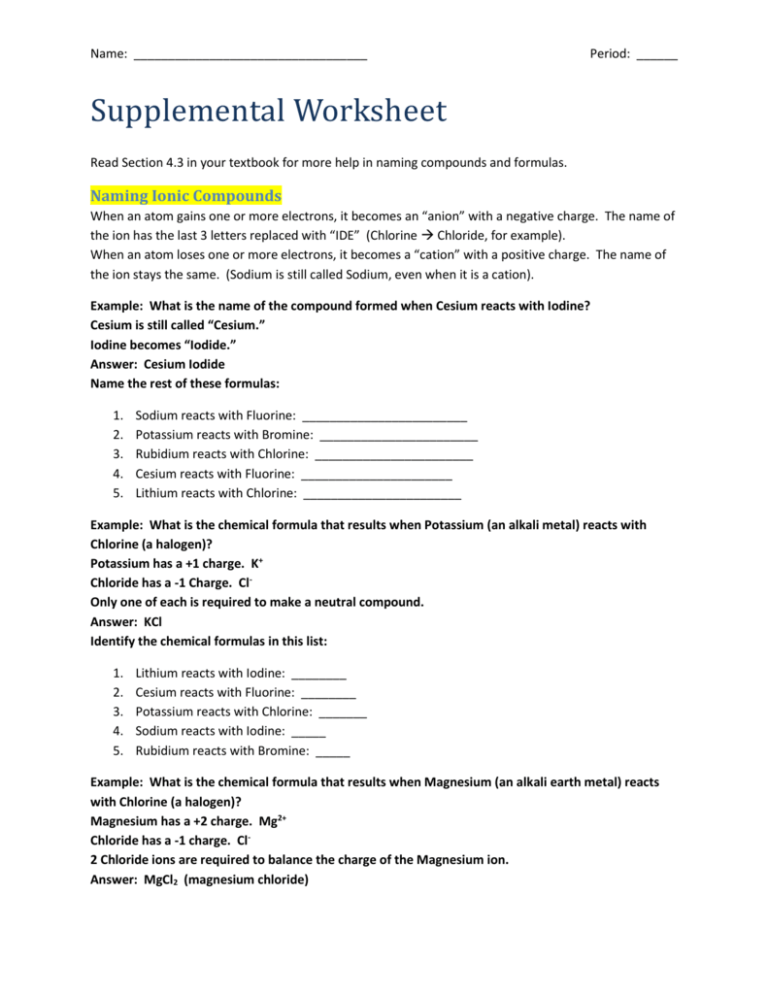
Name: __________________________________ Period: ______ Supplemental Worksheet Read Section 4.3 in your textbook for more help in naming compounds and formulas. Naming Ionic Compounds When an atom gains one or more electrons, it becomes an “anion” with a negative charge. The name of the ion has the last 3 letters replaced with “IDE” (Chlorine Chloride, for example). When an atom loses one or more electrons, it becomes a “cation” with a positive charge. The name of the ion stays the same. (Sodium is still called Sodium, even when it is a cation). Example: What is the name of the compound formed when Cesium reacts with Iodine? Cesium is still called “Cesium.” Iodine becomes “Iodide.” Answer: Cesium Iodide Name the rest of these formulas: 1. 2. 3. 4. 5. Sodium reacts with Fluorine: ________________________ Potassium reacts with Bromine: _______________________ Rubidium reacts with Chlorine: _______________________ Cesium reacts with Fluorine: ______________________ Lithium reacts with Chlorine: _______________________ Example: What is the chemical formula that results when Potassium (an alkali metal) reacts with Chlorine (a halogen)? Potassium has a +1 charge. K+ Chloride has a -1 Charge. ClOnly one of each is required to make a neutral compound. Answer: KCl Identify the chemical formulas in this list: 1. 2. 3. 4. 5. Lithium reacts with Iodine: ________ Cesium reacts with Fluorine: ________ Potassium reacts with Chlorine: _______ Sodium reacts with Iodine: _____ Rubidium reacts with Bromine: _____ Example: What is the chemical formula that results when Magnesium (an alkali earth metal) reacts with Chlorine (a halogen)? Magnesium has a +2 charge. Mg2+ Chloride has a -1 charge. Cl2 Chloride ions are required to balance the charge of the Magnesium ion. Answer: MgCl2 (magnesium chloride) Name: __________________________________ Period: ______ Identify the chemical names and formulas in this list: 1. 2. 3. 4. 5. Beryllium reacts with Iodine: formula: ________ name: _________________________ Magnesium reacts with Bromine: formula: ________ name: _________________________ Calcium reacts with Fluorine: formula: ________ name: _________________________ Strontium reacts with Iodine: formula: ________ name: _________________________ Barium reacts with Chlorine: formula: ________ name: _________________________ Example: What do you get when Calcium reacts with a polyatomic ion, like hydroxide, OH-? Calcium, Ca2+ has a +2 charge. Hydroxide, OH- has a -1 charge. It takes 2 hydroxides to balance the +2 charge of the Calcium. Answer: Ca(OH)2 (Calcium hydroxide) Identify the chemical names and formulas in this list: 1. 2. 3. 4. 5. Sodium reacts with hydroxide: formula: ________ name: _________________________ Magnesium reacts with hydroxide: formula: ________ name: _________________________ Rubidium reacts with cyanide, CN-: formula: ________ name: _________________________ Calcium reacts with nitrate, NO3-: formula: ________ name: _________________________ Barium reacts with sulfate, SO42- : formula: ________ name: _________________________ Example: What do you get when a transition metal, like Copper, reacts with oxygen? Copper can have a +1 or +2 charge as an ion. Oxygen becomes O2- as an ion called Oxide. One copper ion of charge +2 is required for each oxide ion of charge -2 for a neutral compound. But two copper ions of charge +1 are required for each oxide ion for a neutral compound. Answer: CuO, (For Cu+), or Cu2O for (Cu2+). These CANNOT both be called “Copper Oxide” though. Solution: Let’s call Cu+ by the name Copper (I) and Cu2+ by the name of Copper (II). Answer: CuO is called Copper (II) Oxide Identify the chemical names and formulas in this list: 1. 2. 3. 4. 5. Iron (III), Fe3+ reacts with chlorine: formula: ________ name: _________________________ Chromium (II), Cr2+ reacts with hydroxide: formula: ________ name: __________________ Titanium (IV), Ti4+ reacts with oxygen: formula: ________ name: ____________________ Ni2+ reacts with Sulfite (SO32-) formula: ________ name: _________________________ Cd2+ reacts with Carbonate (CO32-) formula: ________ name: _________________________ You are also responsible for understanding how covalent compounds are named. Example: What do you call the formula N2O4? Answer: Dinitrogen Tetroxide (refer to page 126) What is this compound called? 1. P2Cl3 : 2. CO2 : name: _________________________ name: _________________________
